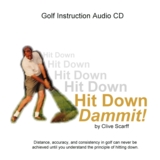Distance & Technology Part 1: Driver
Head Weight
Over the next few
months, as we lead
up to a new golf
season for everyone,
the topic of my newsletter
will be how new Driver
Technology provides
greater distance
to us all.
If there is any
topic you would liked
explained and presented
in my upcoming newsletters,
just email me. I'll
attempt to cover
your topic in a future
newsletter.
If you'd
like one on
one explanations
about the topic,
sign up for the PGI
Member Select Club and
I'll answer all your
questions. Now on
to this week's topic.
I. Clubhead
Weight
Clubhead
weight (or more
correctly, clubhead
mass) is one of
the key contributors
to distance off
the tee. The greater
the mass of the
clubhead and the
great its speed,
the farther the
ball will go. Unfortunately,
the greater the
clubhead's mass,
the slower will
be its speed at
impact. One can't
swing a more massive
(heavier) clubhead
as fast.
The
physics of the
interaction between
club and ball is
quite well understood.
At play are the
laws of momentum
and energy. A given
player (let's say
you) is capable
of swinging a club
with a some maximum
speed. The more
massive the club,
tthe slower will
be this maximum
speed. The speed
of the ball is
a result of the
mass of the clubhead
and its speed.
So, as the mass
increases, so will
the resulting ball
speed. But, since
the clubhead is
more massive, its
maximum speed is
less. There is
actually an optimum
mass for each golfer
that produces the
greatest ball speed.
For most golfers,
that mass is about
200 grams. A physics
equation that determines
the resulting ball
speed is:
V
= U*(1+e)/(1+m/M)
where
U = clubhead speed,
m = mass of ball,
M = mass of clubhead
e
is called the coefficient
of restitution
which is a measure
of the efficiency
of the kinetic
energy transfer
between club and
ball. e has a value
between 0 and 1.
A collision with
e=0 would be like
a club hitting
a putty ball, with
the ball sticking
to the club (maximum
loss in kinetic
energy). A collision
with e=1 is called
a perfectly elastic
collision (no loss
in kinetic energy).
There would be
no heat or sound
produced at all,
so of course is
completely hypothetical.
In
the past 10 to
15 years, club
and ball manufacturers
have made great
leaps in increasing
the e of the
collision due mainly
to the
hollow, metal
faced drivers whose
faces
can "spring
back"
upon collision.
So much so that
the
USGA has put
in place a legal
maximum which
is about 0.83.
Club
testers have
found that e decreases
with increased
clubhead speed.
Tiger Woods'
drives,
therefore, are
not as efficient
as yours or mine.
He makes up for
this by having
significantly
more clubhead speed.
Let's
take the example
that your clubhead
speed is 110 mph
(48.9 m/s), which
means you are a
relatively long
hitter. A typical
value of e (exact
value depends on
the club) would
be about 0.83.
According to the
equation above,
the resulting ball
speed (assuming
a solid hit) would
be:
V =
110*(1+0.83)/(1+46/190)
= 110*1.47 = 162 mph
assuming
a 190 g clubhead
hitting a 46 gram
ball. The ball
speed ends up being
1.47 times the
original clubhead
speed. Let's assume
the amount of energy
you can deliver
to the club is
same no matter
what the mass of
the club. Light
clubs would have
high speed, heavy
clubs would have
low speed, but
the kinetic energy
of the club would
be the same in
each case. The
equation for kinetic
energy is:
KE = 0.5*m*v*v =
0.5*0.19*48.9*48.9
= 227 Joules
where
mass must be in
kg and speed in
m/s. In the table
below are
the resulting
values for
clubhead speed,
e, and ball
speed
using different
mass clubs, assuming
constant kinetic
energy of 227 Joules.
Club Mass (kg) |
Club Speed (mph) |
e |
Ball Speed (mph) |
Ball/Club Speed Ratio |
0.110 |
145 |
0.721 |
176 |
1.214 |
0.130 |
133 |
0.741 |
171 |
1.286 |
0.150 |
124 |
0.757 |
167 |
1.344 |
0.170 |
116 |
0.770 |
162 |
1.393 |
0.190 |
110 |
0.780 |
158 |
1.434 |
0.210 |
105 |
0.789 |
154 |
1.468 |
0.230 |
100 |
0.798 |
150 |
1.498 |
0.250 |
96 |
0.805 |
146 |
1.524 |
Note that it appears that the
less the mass of
the club, the greater
the ball speed. The
assumption made,
however, is that
the kinetic energy
of the club is the
same in all cases.
Realistically, a
golfer cannot obtain
such speeds with
light clubs. As determined
by tests published
in "Search for the
Perfect Swing," the
speeds of the clubs
and the resulting
ball speeds would
be:
Club Mass (kg) |
Club Speed (mph) |
e |
Ball Speed (mph) |
Ball/Club Speed Ratio |
0.110 |
117 |
0.769 |
146 |
1.247 |
0.130 |
116 |
0.770 |
152 |
1.307 |
0.150 |
114 |
0.774 |
155 |
1.358 |
0.170 |
111 |
0.779 |
155 |
1.400 |
0.190 |
109 |
0.783 |
156 |
1.435 |
0.210 |
107 |
0.786 |
157 |
1.465 |
0.230 |
104 |
0.791 |
155 |
1.493 |
0.250 |
102 |
0.793 |
154 |
1.514 |
Ball speed actually peaks when
using a clubhead
with mass 0.210 kg
or 210 g. This result
is for a kinetic
energy of 227 Joules.
Different players
with different swings
and strengths would
all have a slightly
different optimum
clubhead mass. For
most, it is around
200 g, thus most
drivers have clubhead
masses that correspond
to this.
For
most, experimenting
to find the optimum
mass would not yield
very many extra yards.
And, it's not as
simple as adding
a little lead tape
to the clubhead because
that would also change
the center of mass
of the club and the
relative stiffness
of the shaft, both
also determiners
of distance (future
topics). If you happen
to be quite strong
and fit, you might
be able to swing
more massive clubheads
with greater energy,
thus resulting in
more distance. One
can only experiment.
If you
are serious about
trying to optimize
your distance through
clubhead mass, go
to a facility that
has a club/ball monitor
(one that measures
clubhead speed, ball
speed, trajectory,
spin, etc). You can
experiment with different
clubhead masses and
shafts to find the
one that produces
optimum ball speed,
trajectory and spin
(the effects of which
will be discussed
in a future newsletter).
A list of resources that have been used to produce this newsletter
can be found on my
website here.
The next newsletter's topic will be the driver shaft. What is
its optimum mass and
stiffness for greatest
distance?
The focus
of my site is utilize
science and math
to lower your score.
New technology
is one way to achieve
this, but to be
honest, the technology
is one small piece
of the puzzle.
To actually improve significantly,
we all need to:
1. Improve our swings. Hit
Down Dammit!
2. Improve our physical fitness
and strength.
The
Golf Trainer Power
Performance Programô
3. Improve our mental games.
Golf Mind Software
Click on the links above to
take a look at
ways that I personally
use myself and
recommend you try
as well.
One last mention of my latest study on amateur golf scores
and handicaps.
There
are 3 reports:
Report
#1:
Team Events
Report
#2:
Match
Play & Stroke
Allocation
Report
#3:
Birdie
Ratios & Other
Scores
Each
report can be downloaded
immediately for $7.99
or all three can
be purchased for
$19.99.
For
Newsletter Members
Only (that's you),
all three reports
can be purchased
for a special discounted
price of $14.99,
but only by using
the link below.
Take
a closer look at
some of the details
of the reports HERE,
and then come back
here to order.
Pay
$14.99 thru 2CheckOut 
Goods and services
provided by Probable
Golf Instruction
(BC, Canada).
Sold by 2CheckOut.com Inc. (Ohio, USA).
Once
processed by
2CheckOut, you
will be prompted
with a link to
download. Since
the time is very
limited, you
should download
immediately.
OR
Pay
using
Hope
I provided some useful
ways for to become
better prepared for
you best golf season
ever.
Ken Tannar
|






